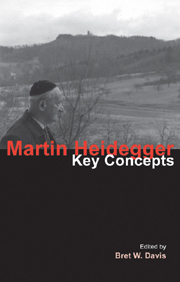Book contents
- Frontmatter
- Contents
- Contributors
- Acknowledgements
- Abbreviations
- Introduction: key concepts in Heidegger's thinking of being
- 1 Hermeneutics of facticity
- 2 Phenomenology: Heidegger after Husserl and the Greeks
- 3 Dasein as being-in-the-world
- 4 Care and authenticity
- 5 Being and time
- 6 The turn
- 7 Heidegger, National Socialism and the German People
- 8 Truth as alētheia and the clearing of beyng
- 9 The work of art
- 10 Ereignis: the event of appropriation
- 11 The history of being
- 12 Will and Gelassenheit
- 13 Ge-stell: enframing as the essence of technology
- 14 Language and poetry
- 15 The fourfold
- 16 Ontotheology and the question of god(s)
- 17 Heidegger on Christianity and divinity: a chronological compendium
- Chronology of Heidegger's life
- Bibliography
- Index
6 - The turn
- Frontmatter
- Contents
- Contributors
- Acknowledgements
- Abbreviations
- Introduction: key concepts in Heidegger's thinking of being
- 1 Hermeneutics of facticity
- 2 Phenomenology: Heidegger after Husserl and the Greeks
- 3 Dasein as being-in-the-world
- 4 Care and authenticity
- 5 Being and time
- 6 The turn
- 7 Heidegger, National Socialism and the German People
- 8 Truth as alētheia and the clearing of beyng
- 9 The work of art
- 10 Ereignis: the event of appropriation
- 11 The history of being
- 12 Will and Gelassenheit
- 13 Ge-stell: enframing as the essence of technology
- 14 Language and poetry
- 15 The fourfold
- 16 Ontotheology and the question of god(s)
- 17 Heidegger on Christianity and divinity: a chronological compendium
- Chronology of Heidegger's life
- Bibliography
- Index
Summary
The term die Kehre – “the turn” – has an over-determined and complex history in Heidegger's work and has led to major misunderstandings of his project. As Heidegger clearly says in Contributions to Philosophy (GA 65 = CP), the turn is simply the bond between Dasein and Sein. Therefore, the turn in its basic and proper sense is the central topic of Heidegger's thought. It is not, as many think, the 1930s shift in Heidegger's approach to his central topic. The Kehre in its basic and proper sense never “took place”, least of all in Heidegger's thinking.
I shall distinguish three meanings of “the turn”: (i) the basic and proper sense – the bond between Dasein and Sein; (ii) the 1930s shift in how Heidegger treated that bond; and (iii) the act of resolve as a transformation in one's relation to that bond.
Because the turn is Heidegger's central topic, explaining it entails reviewing the core of Heidegger's thought. This chapter will attempt to do that within a new key, one that translates Heidegger's technical terms out of an ontological and into a phenomenological register. That re-translation is the necessary prologue to understanding what the Kehre is and is not.
Some conventions: in referring to “the turn” (not “the turning”!) in this chapter, I shall favour the German word Kehre, which Heidegger interprets as the “reciprocity” (Gegenschwung) of Dasein's need of Sein and Sein's need of Dasein.
- Type
- Chapter
- Information
- Martin HeideggerKey Concepts, pp. 82 - 101Publisher: Acumen PublishingPrint publication year: 2009
- 6
- Cited by

